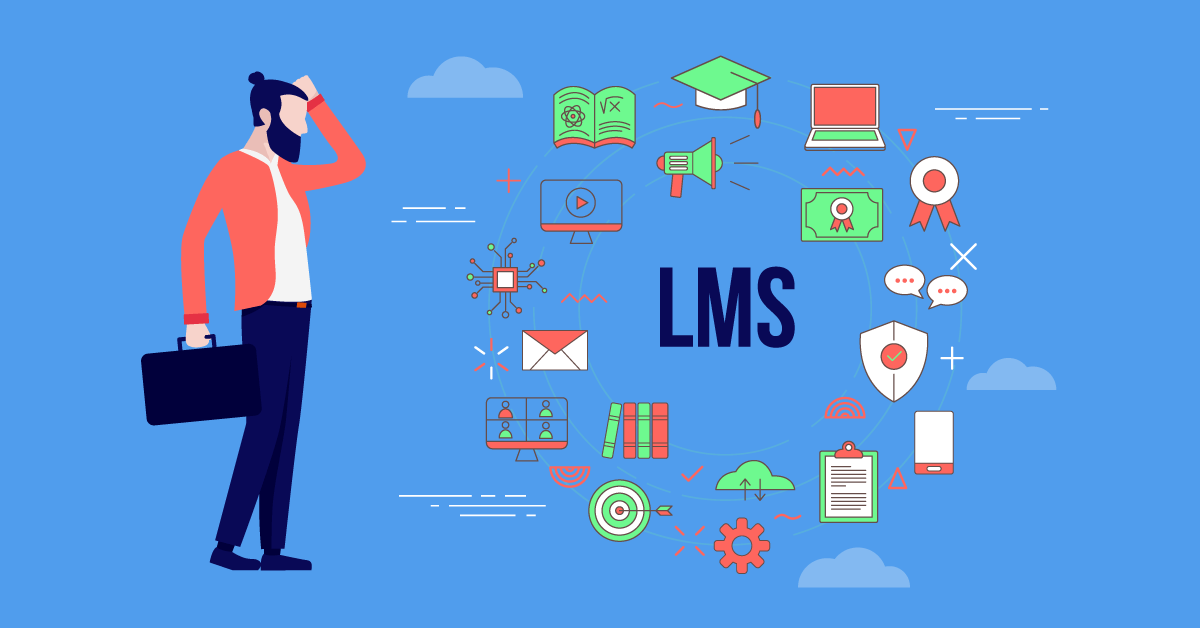According to industry research, out of over 25 different types of training products and services, an LMS is where most companies (39%) intend to invest their funds in 2023.
These stats present a clear picture. Investing in an LMS is a priority for most businesses. What isn’t so clear is how they go about choosing the right LMS. With a market packed full of providers, and each one offering different features, the decision isn’t easy. But it is important. After all, it’s not just your budget that’s at risk. The success of your learning program is at stake too.
This is where our LMS buyer’s guide comes in. If you’re one of the 39% looking for your first eLearning platform, use our LMS evaluation checklist to focus your search. And to pinpoint the best LMS solutions for businesses like yours.
If you’ve already invested in an LMS but have decided to change provider, use it to make sure your next platform has everything you need now and in the future. Going through the buying process again may seem unnecessary. But it ensures your next platform is one you can grow with.
How to choose an LMS for employee training: Questions to guide the LMS selection process
Choosing the right LMS means gathering as much information as possible. And key to this is asking questions. Here’s where an LMS buyer’s guide comes in. The temptation at this early stage is to go straight to each vendor with a list of general, LMS-related queries.
The problem with this is that the answers will only offer a broad overview of what each platform has to offer. And you’ll come away not knowing how any of them relate to your organization. Or your particular training needs. So you need to start by carrying out an internal Q&A. This will form the basis of your LMS buying guide.
From your HR directors and L&D managers to your Customer Success team, Sales directors, IT experts, your CFO, and your CEO, your first step should be to gather as much information as you can from key stakeholders across the business. With a clear idea of what training looks like now—and in the future—you can use your insights to form your LMS buying guide. And frame subsequent discussions with individual vendors.
Of course, asking the right questions is just as important as who you ask them to and when. So, what should your LMS evaluation checklist cover?
Forming the backbone of our LMS buyer’s guide, we’ve compiled two sets of questions. One set is designed to be answered internally. The other is a list of questions for your LMS vendor(s). Between them, they list all of the factors to consider when buying an LMS. By comparing the answers, you’ll be able to see which provider offers the best solution for you.
LMS buying guide: 10 questions to ask internally
1. What’s the (real) problem we want our LMS to solve?
Chances are you’ve got two answers to this question.
One is likely to be a practical problem related specifically to learning. (Delivering onboarding training to a large number of new hires, for example.) The other will be linked to this but have a more strategic outcome. (To improve employee retention by reducing the turnover rate for new hires, for example.)
Both of these are good reasons for investing in an LMS. But focusing purely on features that can solve an immediate practical problem is a missed opportunity. Far better to look beyond the immediate challenge to identify a measurable organizational goal. Doing this will ensure you invest in an LMS that’s not just feature-rich but also future-focused.
2. How many people do we need to train?
Knowing how many learners you need to accommodate will have a bearing on cost. It also captures the scale of your training operation, which will influence the type of eLearning solution you need (basic or enterprise, for example). And the level of ongoing support.
Remember, it’s not just your training numbers now that matter. To avoid having to switch providers again, map out your projected numbers at different stages over the next few years.
3. Where are our learners located, and how will they access their training?
If you have distributed teams or customers, or a remote or mobile workforce, your LMS needs to offer more than just an online portal. The content design and delivery methods must support learners using different devices and not just a PC.
To know the level of flexibility needed, consider where your learners are located: on-site, at home, or on the road. This information will determine how they access training (for example, tablets, mobiles, or laptops). And the format required to make this type of training a success (microlearning, hybrid or blended learning, for example). Remember to factor in future changes too. If you’re moving towards a more hybrid working model, hiring for new (remote) roles, or expanding your customer base, capture this information alongside your current requirements.
3. What does the training pattern look like?
Is training at your organization constant? Or are there peaks and troughs? If you understand the rhythm of your L&D offering, you can work out what payment model best suits you. And what level of admin functionality and automation you need to manage your learning lifecycle.
When it comes to payment, most LMSs operate on a stored user model. Which means you pay for every user in the portal whether they’re logging in or not. If you’re an SMB with an irregular or seasonal pattern, this model isn’t economical. So, look for an LMS that offers an active user model. Or the option to choose between the two.
4. Who is our training designed for?
Corporate training can have many different use cases. And each of these use cases may demand different things from an LMS. For example, the ability to segment learning according to different groups. Or even create custom training portals with unique brand, design, and language standards. To identify your use cases, consider the following:
- Are you 100% focused on external training (customers or partners, for example)?
- Is your sole use case delivering internal training to employees?
- Do you need to provide both types of training? Internal and external.
- Will different learners have different language and timezone requirements?
- Is your provision likely to change in the future?
Pro tip: A multi-audience, enterprise LMS supports all of these different use cases in one centralized system. Its flexibility makes it the ideal solution if you’re an extended enterprise. If you’re planning to scale up your training in the future. Or if you’re simply not sure.
5. What kind of training methods do we use?
If your courses are instructor-led, you might rely heavily on video-conferencing. Or organize lots of live, in-person events. For self-paced, blended, or hybrid learning, your delivery methods will be more varied. As will the type of content you create. Understanding your training model(s) highlights the LMS features and functionality you’ll need. It also helps assess the impact on storage and cost.
6. What are our content requirements?
When it comes to training content and your choice of eLearning platform, the big question is: Have you already created all of your own courses or not?
If the answer’s ‘yes,’ you’ll be looking for an LMS that can effectively manage the volume of content you’ve produced. And support all of the different content formats. If the answer’s ‘no,’ look for an LMS with a built-in content library. Or an easy-to-use eLearning content authoring tool.
7. How quickly do we need to go live with our new LMS?
In an ideal world, the decision to invest in a training platform shouldn’t be based around tight timeframes. After all, a rushed decision now could mean having to switch providers again in a few years. But in reality, the decision to invest in an LMS is often driven by a specific event or external requirement.
You may, for example, have a new batch of customers who need to be onboarded. Or a new product or feature that existing customers need training on. Perhaps there’s a statutory training program or company-wide compliance course that needs to be completed? Either way, timing may well be an issue. So it’s important to establish early on if there’s a hard deadline you need to meet. And what you need from an LMS to make that a reality.
8. What level of support will we need?
The scale and complexity of your training impact the level of support required from an LMS vendor. Enterprises might prefer ongoing troubleshooting with a dedicated account manager. Small businesses might find a self-service approach enough. To narrow it down, dig deeper by asking:
- How complex is our training operation?
- Are we migrating from one LMS to another? If so, how much data do we need to import?
- Do we have a dedicated training team that can help with data migration/setup/implementation?
- How will downtime affect us?
- How many members of our training team have used an LMS before? What level of experience do they have?
Pro tip: Choosing a well-designed, easy-to-use, and intuitive LMS will reduce the level of support you need. So make sure you ask for a demo to check usability before you invest.
9. What does our full learning ecosystem look like?
At its most basic, an LMS is a way of managing training. Many platforms are far more sophisticated and offer enhancements that elevate the experience for admins and end users. But there are still functions linked to the L&D lifecycle that an LMS platform can’t perform. Which is where integrations come in. By connecting with third-party platforms (video-conferencing or webinar tools, online calendars, messaging apps, or eCommerce services), an LMS becomes far more powerful.
Chances are you’re already using tools like these to help deliver training. So you’ll want to make sure the LMS you choose supports them. Start by making a list of everything in your tech stack. And don’t just include platforms that perform practical training tasks. Sharing data and tracking training across relevant systems matters too. Which is why your HRIS, CRM, and any authoring tools you use should be factored in, too.
10. How can I get the best ROI?
An LMS is an investment. And the amount you commit will depend on many of the factors we’ve discussed here. For example, the number of users, level of support, content requirements, and scalability. So, you need to balance cost with the potential ROI.
To do this, ask yourself: Will it lead to improved training outcomes, increased productivity, and cost savings in the long run? If you have a fixed figure or pricing structure in mind, also consider the following: ‘What are our must-haves and what are our nice-to-haves?’ And ‘How do we want to pay?’ (For example, monthly subscription or upfront payment?)

LMS buying guide: 50 questions to ask your LMS vendor(s)
You’ve used LMS evaluation criteria to carry out a thorough review of your organization’s training needs now and in the future. The next step in your LMS selection process is to use the insights you’ve gathered to create a list of questions to ask vendors. These should reflect your key concerns and areas your LMS evaluation checklist has pinpointed as being important.
The following list has 50 possible questions. Not all of these will be relevant to your use case. Pick and choose what you want to focus on. But remember to factor in future requirements as well as current ones.
Pricing
- Is there an implementation fee? How much is it?
- What types of payment plans do you offer?
- What is included in each payment plan?
- How many users can I have?
- How many courses can I create?
- Is payment based on a stored user model or an active user model?
- How can I upgrade or downgrade my pricing plan?
- What is your cancellation and refund policy?
- What are the payment options, and how do these relate to deployment?
- Are there upfront licensing fees?
- Are there costs associated with storage and/or hosting?
Functionality and Feature
- Can admins and learners access training through their phones? How does it work?
- How does training work on different platforms?
- Does the LMS support social learning?
- Is there an in-built content library?
- Is there an in-built content authoring tool?
- Do you support SCORM and xAPI?
- Do you offer sub-accounts or branch functionality?
- What languages do you support?
- What level of customization do you provide? (whitelisting, reporting, branding, portals)
- What metrics can I report on?
- Do you offer advanced reporting?
- Are reports downloadable?
- What other third-party platforms do you integrate with?
- Do you offer native integrations?
- How does the LMS support personalized learning?
- What kind of interactivity/gamification is available?
- Do you support SSO?
- Can I have a demo or free trial?
- Can an admin perform bulk actions?
Provenance and Credibility
- Do you have other customers from my industry/country?
- Can I get in touch with any of your customers?
- Can you provide me with relevant customer case studies?
- Can you share some of your reviews?
Implementation
- What’s the delivery time?
- How many hours, on average, will I need to spend on implementation?
- How does data migration work?
- What IT resources will I need to provide?
- Do you offer personalized integration and configuration support?
Support
- What levels of customer service do you offer?
- Do you offer live chat and/or priority support?
- Is there global 24/7 support available?
- Can you help with onboarding new users/learners?
- What self-serve resources do you provide?
Security
- What security features are in place to keep my content and user data secure?
- Do you have a disaster recovery plan?
- Where will my data be housed, and who will have access to it?
- What third-party compliance certificates does your LMS have?
- Are your employees part of an employee security awareness program?
- How can I contact the Security team about a vulnerability on your site or other security issues?
A springboard to success: Why your LMS buyer’s guide is just the start
You’ve asked the questions. And you’ve got your answers. But how do you use those answers to make a final decision? The first step is to involve relevant stakeholders across your business. For example, your CFO can evaluate responses that relate to pricing and budget. Your IT manager can do the same for cybersecurity and technical requirements. And your customer success lead can share their opinion on the support and reporting elements.
The next step is to compare the answers from different vendors. There’s no right or wrong way to approach an LMS pricing and features comparison. But applying a point or scoring system to your LMS buyer’s guide is a good place to start. To do this, rank answers according to their importance (for example, what’s essential, what’s a nice-to-have, and what’s a future requirement). And then score each vendor’s responses.
Then you need to factor in usability. An LMS buyer’s guide is ideal for gathering information. But it can’t recreate an experience. So make sure you follow up your Q&A with a live demo or free trial. And use this as part of your LMS evaluation criteria. And finally, find out what other organizations like yours are saying. An LMS buyer’s guide is the best way to kickstart an LMS comparison, and reviews are a good way to round it off.



